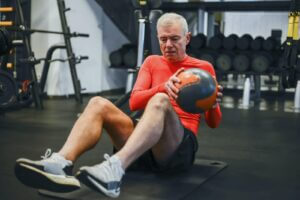Prepare for the ultimate running adventure! Long-distance running requires more than just lacing up and hitting the road. It demands a strategic warm-up routine that sets the stage for success. In this blog post, we unveil essential warm-up tips designed specifically for long-distance runners.
Boost your performance, prevent injuries, and unlock your full potential by incorporating these tried-and-true strategies. From increasing blood flow to sharpening mental focus, a well-executed warm-up routine can be the key to conquering those miles.
So, join us as we dive into the world of warm-up rituals and elevate your running game to new heights. Let’s go the distance together!
Table of Contents
Why Warm-up Matters for Long-Distance Running

When it comes to long-distance running, warming up may seem like an unnecessary step in the race to the finish line. After all, shouldn’t we conserve our energy for the miles ahead?
Well, it turns out that a proper warm-up routine can give you a competitive edge and make those miles feel a little less daunting. Let’s dive into why warming up matters for long-distance running.
A. Increased Blood Flow and Oxygen Delivery to Muscles
Imagine your muscles as a well-oiled machine. When you start running, your body demands an increased blood flow and oxygen supply to fuel those hardworking muscles.
Warming up gets your heart pumping, sending a rush of oxygenated blood to your muscles, priming them for the miles ahead. This increased blood flow helps to loosen up the muscle fibers, allowing for better muscle performance and reducing the risk of cramping or strains.
B. Enhanced Joint Mobility and Flexibility
Long-distance running requires a fluid and efficient range of motion in your joints. Warming up helps to increase joint mobility and flexibility by gently lubricating the joints and loosening up the surrounding muscles and connective tissues.
This prepares your body for the repetitive and demanding movements of running, reducing the risk of joint discomfort or injury. So, think of your warm-up as a way to oil those creaky joints and ensure smooth movement on the road.
C. Mental Preparation and Focus
Running long distances isn’t just a physical challenge; it’s also a mental one. Warming up allows you to transition from a sedentary state to an active and focused mindset. It gives you a chance to mentally prepare for the task ahead, psyching yourself up for the journey.
By engaging in a warm-up routine, you signal to your brain that it’s time to shift gears and get into the running zone, boosting your mental clarity and concentration.
As we can see, warming up plays a vital role in long-distance running by improving blood flow, enhancing joint mobility, and sharpening your mental focus. Now that we understand the importance of warming up, let’s explore the key components of an effective warm-up routine in the next section.
By incorporating these essential tips into your pre-run ritual, you’ll be setting yourself up for a successful and injury-free long-distance running experience.
Components of an Effective Warm-up Routine

To unlock your true running potential and set yourself up for long-distance success, it’s crucial to have a well-designed warm-up routine. Just like a finely tuned engine, your body needs a proper warm-up to reach its optimal performance level. Let’s dive into the key components of an effective warm-up routine, tailored specifically for long-distance running.
A. General cardiovascular warm-up
Picture this as the ignition sequence before launching into your run. Start with a light jog or brisk walk to gradually increase your heart rate and get your blood flowing.
This gentle introduction primes your cardiovascular system, ensuring a smooth transition into higher intensities. Alongside jogging, incorporate dynamic stretching exercises to activate and mobilize the major muscle groups.
B. Muscle activation exercises
It’s time to awaken those dormant muscles and prepare them for the miles ahead. Leg swings and lunges are fantastic for loosening up your hip flexors, while also engaging your glutes and hamstrings.
High knees and butt kicks help activate the hip extensors and quadriceps, enhancing their responsiveness. Don’t forget hip rotations and leg circles, which provide additional mobility benefits to your lower body.
C. Specific warm-up drills for running
Here’s where the magic truly happens. Specific warm-up drills mimic the movement patterns of running, fine-tuning your neuromuscular coordination and enhancing running efficiency.
The A-series drills, including A-skips, A-walks, and A-runs, help refine your stride mechanics, improve hip extension, and increase your leg turnover rate.
Take it up a notch with the B-series drills, such as B-skips and B-runs, which enhance coordination and power. Finally, stride-outs or accelerations allow you to gradually build up your speed, transitioning seamlessly into your actual running pace.
By incorporating these components into your warm-up routine, you’ll not only reduce the risk of injury but also optimize your performance during long-distance runs. Remember, a well-prepared body is more resilient and efficient, allowing you to push beyond your limits and achieve your running goals.
Stay tuned for the next section, where we’ll delve into the optimal duration and timing of your warm-up, ensuring you hit the road at the right moment with the right level of readiness.
Duration and Timing of Warm-up

A. Recommended warm-up duration
Warming up before a long-distance run is like revving the engine before embarking on an epic journey. It sets the stage for optimal performance and prepares your body for the rigors of endurance running. While the specific warm-up duration may vary depending on individual preferences and needs, a general guideline is to allocate around 10 to 15 minutes for your warm-up routine.
B. Scheduling the warm-up relative to the race or training session
1. Timing before a race or event
Timing is everything, especially when it comes to your warm-up routine on race day. Arriving at the starting line without properly priming your body can leave you feeling sluggish and unprepared. Aim to complete your warm-up approximately 30 to 45 minutes before the race begins. This allows enough time for your body to activate and your muscles to reach their optimal temperature.
2. Adjusting warm-up for training runs
While training runs may not have the same level of pre-race anticipation, they still require a thoughtful warm-up to maximize your training benefits. The timing of your warm-up can be adjusted depending on the intensity and duration of the run.
For shorter training runs, a warm-up period of 5 to 10 minutes may be sufficient. However, for longer training sessions or high-intensity workouts, it’s advisable to allocate a bit more time, around 10 to 15 minutes, for a comprehensive warm-up.
3. Matching Your Warm-up to Training Demands
The key is to tailor your warm-up to match the demands of your training session. If you’re planning a long, steady run, a slightly longer warm-up can help you ease into the extended effort. On the other hand, if you’re embarking on a speed workout or interval training, a more dynamic warm-up that includes drills and strides will better prepare your body for a faster pace and intense effort.
By understanding the importance of timing, you can ensure that your warm-up routine aligns perfectly with your long-distance running goals. So, next time you’re lacing up your running shoes, remember to schedule your warm-up wisely and get your body primed for the road ahead.
Tips and Considerations

When it comes to warming up for long-distance running, it’s not just about going through the motions. Paying attention to your body and making necessary adjustments can make a world of difference in your performance. Here are some tips and considerations to keep in mind:
A. Listen to your body and adjust the warm-up routine accordingly
Your body is a remarkable machine, and it knows what it needs. Pay close attention to how your muscles and joints feel during your warm-up. If something feels tight or sore, take a few extra minutes to focus on stretching and mobility exercises for those specific areas. Likewise, if you’re feeling particularly energized, consider incorporating some additional dynamic movements to prepare your body for the run ahead.
B. Incorporate foam rolling or self-massage techniques
Foam rolling, also known as self-myofascial release, can work wonders for your warm-up routine. This technique involves using a foam roller to apply gentle pressure to different areas of your muscles, helping to release tension and improve blood flow. Spend a few minutes rolling your calves, quads, hamstrings, and any other tight spots you may have. Not only will this help to loosen up your muscles, but it can also aid in preventing injuries during your long-distance run.
C. Hydration and fueling before the warm-up
Proper hydration and fueling are crucial for any type of exercise, and long-distance running is no exception. Before your warm-up, make sure you are adequately hydrated by drinking water or a sports drink. Additionally, fuel your body with a light, easily digestible snack that provides carbohydrates for energy. Opt for options like a banana, energy bar, or a small bowl of oatmeal. This way, your body will have the necessary fuel to perform at its best during your run.
Remember, warming up is not just a mundane task to check off your list. It’s an opportunity to prepare your body, both physically and mentally, for the demands of long-distance running. By listening to your body, incorporating foam rolling, and ensuring proper hydration and fueling, you’ll set yourself up for a successful and enjoyable run ahead.
Precautions and Common Mistakes to Avoid
When it comes to warming up for long-distance running, it’s crucial to avoid certain pitfalls that could hinder your performance and put you at risk for injuries. Let’s delve into some precautions and common mistakes to steer clear of, ensuring that your warm-up routine sets you up for success.
A. Not rushing through the warm-up process
Picture this: You’re eager to hit the pavement and start your long-distance run. The temptation to skip or rush through your warm-up routine might be strong. However, resist the urge to do so! Your warm-up is like a prelude to the main act, preparing your body and mind for the upcoming challenges.
Instead, take the time to gradually increase your heart rate and body temperature. This allows your muscles, tendons, and ligaments to adapt to the demands of running, reducing the risk of strains and sprains. A rushed warm-up can leave you ill-prepared for the distance ahead, both physically and mentally.
B. Avoiding static stretching before running
In the past, static stretching was commonly practiced as part of a warm-up routine. However, recent research suggests that static stretching before running can impair your performance and decrease muscle power. Save those static stretches for your post-run cooldown.
Instead, focus on dynamic stretching exercises during your warm-up. Dynamic stretches involve controlled movements that mimic the actions you’ll perform while running. These movements promote muscle activation, improve range of motion, and prepare your body for the dynamic nature of long-distance running. Embrace exercises like leg swings, lunges, and hip rotations to warm up your muscles functionally and effectively.
C. Gradual increase in intensity during warm-up
Imagine revving up a car engine from idle to maximum RPM in a split second. Not a good idea, right? The same principle applies to your warm-up routine. It’s essential to gradually increase the intensity of your warm-up, allowing your body to adapt and prepare for the demands of long-distance running.
Start with a gentle cardiovascular warm-up, like jogging or brisk walking, to get your blood flowing and warm up your muscles. Then, progress to more dynamic movements such as high knees, butt kicks, and leg circles. These exercises activate specific muscle groups and prime them for the running motion.
By gradually building up the intensity of your warm-up, you optimize blood circulation, increase joint mobility, and enhance your overall performance. It’s like giving your body a chance to shift into gear, ensuring a smoother and more efficient run ahead.
Conclusion
In conclusion, warming up is a crucial component of long-distance running preparation. By incorporating an effective warm-up routine into your training regimen, you can enhance your performance, reduce the risk of injury, and improve your overall running experience.
Remember to prioritize cardiovascular warm-ups, muscle activation exercises, and specific running drills. Pay attention to the duration and timing of your warm-up, listen to your body, and avoid common mistakes. Implement these essential warm-up tips and get ready to conquer those long miles! For more valuable insights on running and fitness, be sure to check out my other articles on Fast Footers.


